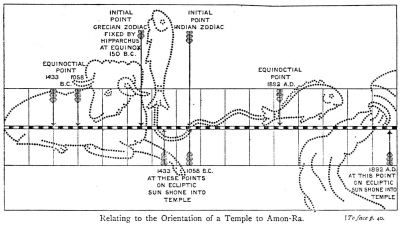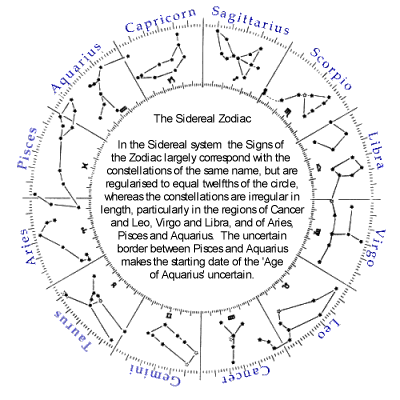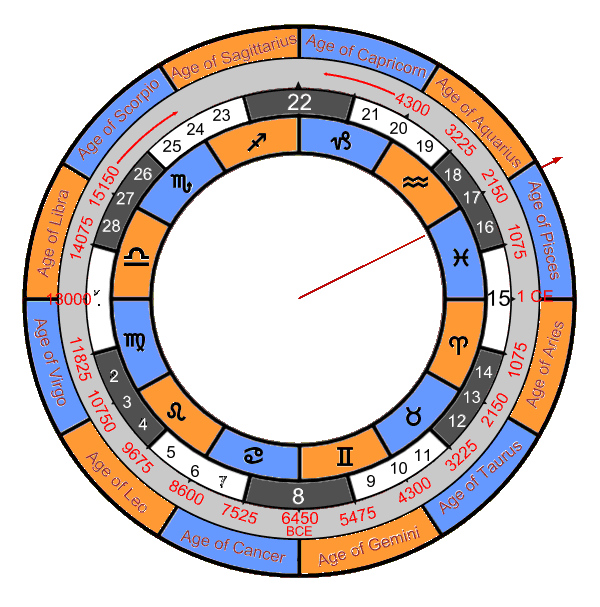As a result of the Precession of the Equinoxes, the Sun’s position at the Vernal Equinox shifts backwards through the Zodiac over the course of the centuries. If the current rate of change remains steady, it will complete a full circle in 25 786 years. Since this represents a passage of the Sun through the Zodiac, albeit backwards, it is taken by astrologers to be a kind of year, the Great Year, in which the Sun’s position in a constellation therefore represents a kind of astrological month, often referred to as an ‘Age’, lasting some 2 150 years. The period when the Vernal Equinox was in Taurus is therefore often called the Age of Taurus, when it was in Aries, the Age of Aries, and so on. These Ages are exactly the same as the periods of ‘two thousand and odd years’ (AV B 29) set out by Yeats in A Vision.
The oldest list of marking stars that we have, the Babylonian Mul.Apin list (after 1000 BCE), starts with the asterism of the Pleiades (later included in the constellation of the Bull, Taurus) heading a list of 17 or 18 asterisms and constellations marking the ecliptic, and ends with Mul.Lu.Hun.Ga (the ‘Hired Man’, changed into the Ram by the Greeks). The figures of Taurus and Aries face in opposite directions, so as equinoctial point shifted from the Pleiades, in the shoulder of the Bull, it moved towards towards the tail of Aries and gradually towards its head.

The ceiling of Grand Central Terminal, New York, shows the traditional depiction of Bull and
Ram facing in opposite directions. The Pleiades are situated in the shoulder of Taurus.
The ceiling follows the convention of celestial globes of viewing the stars from ‘outside’
so the image is reversed here to show the constellations as they actually appear in the sky.
In the 2nd century BCE, Hipparchus, who first noted the Precession of the Equinoxes, established the concept of the ‘first point of the sign of Aries’ defined by the equinox (see panel below). When astrology and astronomy were formalised and systematised in the Hellenistic culture of the Roman Empire, most notably by the Alexandrian Greek, Claudius Ptolemy (?85-?165 CE), the Sun’s position at the equinox was still at the border between the constellations of Aries and Pisces, and at around this date the Sidereal Zodiac of the stars and the Tropical Zodiac of the equinoxes coincided exactly. Gradually, however, they drifted apart again, so that the equinoctial point has now moved through Pisces to the border with Aquarius; however it is still called the First Point of Aries, by astronomers as well as astrologers, and taken as the start of the Equinoctial or Tropical Zodiac.

This page was marked in Yeats’s copy, disputing the dates: next to the line ‘Initial Point Grecian Zodiac Fixed by Hipparchus at Equinox 150 B.C.’, Yeats wrote ‘No – number / understand that place of equinox / 150 A. D. not initial point’. This implies that Yeats understood that this was the position of the Equinox or tropical ‘First Point of Aries’ rather than the start of the constellation of Aries and in 150 A.D. rather than B.C. Although ‘ìnitial point’ would generally indicate the First Point of Aries, Yeats is probably disputing the date of when the Tropical and Sidereal Zodiacs coincided. This is usually considered to be after 200 AD/CE and ‘Lahiri's ayanamsa’, the most widely used in India, puts it at 285 CE.
Indian astrology continued to use the Zodiac of the stars, while Hellenistic and Perso-Arabian astrology used the Zodiac of the equinoxes. Western astrology follows this latter tradition of the Tropical Zodiac, so that the Sun is said to be ‘in Aries’ for the thirty days that follow the Vernal Equinox, even though its apparent position with respect to the stars is then aligned with the constellation of Pisces. A child who is born during these thirty days is said to have the Sun in Aries, and its character will be represented accordingly. Someone observing the sky at this period would however find that the stars blotted out by the Sun’s brightness were in the constellations of Pisces and Aquarius.
In the case of the child, the Sun’s apparent position with respect to the constellations is not held to be important. However, within the larger scheme of the Great Year, the Vernal Equinox’s position in Pisces is said to bring a Piscean influence to bear upon the whole world, which passes through the ‘Age of Pisces’.
‘There are several remarkable cycles that come to a close at the end of this century [nineteenth]. First, the 5,000 years of the Kaliyug cycle; again the Messianic cycle of the Samaritan (also Kabalistic) Jews of the man connected with Pisces (Ichthys or "Fish-man" Dag). It is a cycle, historic and not very long, but very occult, lasting about 2,155 solar years, but having a true significance only when computed by lunar months. It occurred 2410 and 255 B.C., or when the equinox entered into the sign of the Ram, and again into that of Pisces. When it enters, in a few years, the sign of Aquarius, psychologists will have some extra work to do, and the psychic idiosyncrasies of humanity will enter on a great change.’
Helena Blavatsky, ‘The Esoteric Character of the Gospels: Part 1,’ Lucifer 1:174, note 5.
‘The great Sidereal year is the period taken by the equinoctial points to make in their precession a complete revolution of the heavens. It is composed of 25,868 solar years almost. It is said that the last sidereal year ended about 9,868 years ago, at which time there must have been on this earth a violent convulsion or series of such, as well as distributions of nations. The completion of this grand period brings the earth into newer spaces of the cosmos, not in respect to its own orbit, but by reason of the actual progress of the sun in an orbit of its own that cannot be measured by any observer of the present day, but which is guessed at by some and located in one of the constellations.’
William Quan Judge, The Ocean of Theosophy (NY & London: The Path & Theosophical Publishing Society, 1893), 121.
As the equinox is approaching Aquarius, this has given rise to the idea of ‘the dawning of the Age of Aquarius’ (as in the song from the musical, Hair), and the word ‘Aquarian’ is sometimes used as a synonym of ‘New Age’ (itself a vague enough term) with respect to ‘alternative culture’, in particular spirituality outside traditional religious systems.
Though the idea entered popular culture only at the end of the twentieth century, it was widely discussed in esoteric circles much earlier. In 1896 George Russell (AE) wrote to Yeats, for instance, that ‘I agree with you that we belong to the coming cycle. The sun passes from Pisces into Aquarius in a few years. Pisces is phallic in its influence. The waterman is spiritual so the inward turning souls will catch the first rays of the New Aeon’ (CL 2, 7n, [February 1896]; Yeats’s letter is lost).
There is no exact date for transitions, since the borders between the constellations are naturally vague, although when applied to the Sidereal Zodiac they are regularised to 30° each and boundaries are clearer. Those who take the 30° segments as the boundaries consider that the age is dawning now. Those who take the constellations as the reference frame see the transition as some way off, since the constellation of Pisces is significantly longer than 30° (see right); the date for the transition to the constellation of Aquarius is sometimes given as late as 2600CE.
That the birth of Christ took place at the transition not just from Aries to Pisces but from the first sign of the Zodiac to the twelfth, therefore starting a new cycle, is no accident in this system. It regards the rise of monotheistic religions with universal scope as a phenomenon of the new Age of Pisces, and the universal Christian church as the primary manifestation of the epoch. Similarly, the dating of the eras from the computed birth of Christ is regarded as humanity synchronising its calendar with the Ages.


Mithras slaying the bull, surrounded by the zodiac. Relief discovered in Walbrook in the City of London in 1889. The full Mithraeum in London was excavated in the 1950s.
Ironically, perhaps, the notion of the precession giving rise to ‘ages’ appears to originate in Enlightenment scepticism and anti-religious writers, who traced the iconography of religions to the stars and saw changes of cultic imagery mirroring in particular the constellation of the Vernal Equinox in the northern hemisphere. ‘Do you ignore, that two thousand years before the Christian era, to which epoch the religion of the Persians and the Mithraic worship, or the Bull of Mithras is traced,—the Sun made the transit of the equinox under the sign of the Bull, and that it is merely through the effect of the precession of the equinoxes, that this passage in our days is under the sign of the Lamb; that there is nothing changed but the celestial forms and the name? That the worship is absolutely the same?’
Charles Dupuis, Origine des tous les cultes , ou, Réligion universelle (Paris: H. Agasse, 1795).
‘People of Japan! your bull, which breaks the mundane egg, is only the bull of the zodiac, which in former times opened the seasons, the age of creation, the vernal equinox. It is the same bull Apis which Egypt adored, and which your ancestors, O Jewish rabbins! worshipped in the golden calf. This is still your bull, followers of Zoroaster! which, sacrificed in the symbolic mysteries of Mithra, poured out his blood which fertilized the earth. And, ye Christians! your bull of
the apocalypse, with his. wings, symbol of the air, has no other origin ; and your lamb of God, sacrificed, like the bull of Mithra, for the salvation of the world, is only the same sun, in the
sign of the celestial ram, which, in a later age, opening the equinox in his turn, was supposed to deliver the world from evil—that is to say, from the constellation of the serpent, from that great snake, the parent of winter, the emblem of the Ahrimanes or Satan of the Persians, your instructors.’
C. F. Volney (C. F. Chasseboeuf Boisgirais), Ruines, ou Méditations sur les révolutions des empires (Paris: Desenne, 1791). Thomas Jefferson translated the bulk of this so-called "Paris translation", while Vice President, but it was finished by Joel Barlow and published with Barlow's name associated.
With the precession of the equinoxes: ‘The relative positions of the signs and constellations in the zodiac and ecliptic seem thus to have gradually changed with the revolving years; and the worship of the three constellations, Taurus, Aries, and Pisces, with which Christianity is so intimately connected, seems to have changed in a corresponding degree. The worship of the bull in Egypt—the celestial Taurus—has given place to that of the lamb of Palestine—the celestial Aries; and under the astronomical emblem Pisces—the twelfth sign of the zodiac—the dominant faith of today was appropriately taught by the twelve apostolic fishermen. . . . As the precession of the equinoxes continues as of yore and as the masses still continue credulous and devout, they may in succeeding ages be again called upon to worship the god Apis, when the sign of Taurus shall again coincide in the zodiac and the ecliptic; and Aries, "the lamb of God," may again be offered in the fullness of time as a sacrifice for mankind, again be crucified, and again shed his redeeming blood to wash away the sins of a believing world.’ CYGNUS, the Swan.--An old constellation in the milky-way, between Equus and the Dragon. This is fabled to be the swan into which Jupiter transformed himself in order to deceive the virtuous Leda, wife of Tyndareus, king of Sparta. The Grecian matron, like the Jewish virgin, thus became the mother of a God. Appendix to 1890 English translation of Volney's Ruins (Jefferson/Barlow translation). The appendix is announced to be ‘Compiled by the publisher [Peter Eckler] from recognized authorities’.
For a recent consideration, in a somewhat different context, see, for example, J. Z. Buchwald and D. Greco Josefowicz, The Zodiac of Paris (Princeton: Princeton University Press, 2010), esp. chs 2 and 3.
Complementary Signs
The equinox that is marked by the Sun’s passage northward across the equator in March and fixes the First Point of Aries is generally referred to as the Spring or Vernal Equinox. However, properly speaking this only applies to the northern hemisphere. For the southern hemisphere this equinox marks the onset of fall or autumn and is their Autumnal Equinox. Conversely September’s equinox, when the Sun is passing southwards over the equator and fixing the beginning of tropical Libra, is the Vernal or Spring Equinox in the southern hemisphere and the Autumnal Equinox in the northern. Each equinox is therefore vernal for half of the globe. Therefore when the northern hemisphere’s Vernal Equinox takes place in the constellation of Pisces in March, the corresponding southern Vernal Equinox takes place in the constellation of Virgo in September. Each Age therefore unites the two opposite signs, and should be called the Age of Taurus-Scorpio, Aries-Libra, Pisces-Virgo and Aquarius-Leo. Opposite signs are often considered to share many underlying traits, those of the first six signs (Aries to Virgo) being directed inwards to personal or selfish ends and their counterparts in the last six signs (Libra to Pisces) being directed outwards to social or external ends. (The Mundane Houses are similarly patterned.) For example, Virgo and Pisces have in common a concept of service and a degree of self-abnegation, but the service of Virgo is represented by Martha, dutiful and efficient, while that of Pisces is represented by Mary, emotional and extravagant. Therefore, although there may be some conflict in the polarity, there is also an underlying common ground.The Divisions of the Ages
The following attributions are given as those generally cited to illustrate the Astrological Ages, and are somewhat selective and anecdotal in their application. Migrations of people are certainly debated with regard to date and routes, and the dates for changes and innovations also show plenty of variation and disagreement.
The dates of the ages given here are based upon twelve equal divisions of the precessional cycle, taken as 26 000 years, with the Age of Pisces starting with the Common Era, the date of Jesus Christ’s birth as calculated in the sixth century by Dionysius Exiguus. This arrangement follows Julia and Derek Parker, The Compleat Astrologer (1971), 44-45 (cf. Parkers' Astrology [1991], 24-25, and see also Nicholas Campion, The Practical Astrologer [1987/1993], 142), but allotting a full 2,150 years to each period, rather than the rounded 2,000 the Parkers use.
The Historical Ages | ||
|---|---|---|
| The Age of Libra | ca. 15150 BCE-13000 BCE | Lascaux cave paintings. Arrival of humans in America across Bering land bridge. |
| The Age of Virgo | ca. 13000 BCE-10750 BCE | End of last Ice Age. Clay Pottery. First intensive hunter-gatherer culture. First agriculture in Near East. |
| The Age of Leo | ca. 10750 BCE-8600 BCE | Stone age. First towns (Jericho). |
| The Age of Cancer | ca. 8600 BCE-6450 BCE | Copper first used. Alcoholic fermentation discovered. Mother goddesses. |
| The Age of Gemini | ca. 6450 BCE-4300 BCE | Start of writing systems and accounting. Increased trade. |
| The Age of Taurus | ca. 4300 BCE-2150 BCE | Rise of Mesopotamian and Egyptian civilisations. Bronze age in Greece, rise of Minoan and Mycenean cultures. Consolidation of agriculture, building of pyramids and megaliths. Bull cults in Assyria, Egypt, Crete. |
| The Age of Aries | ca. 2150 BCE-1 CE | Bronze age in Central Europe. Arrival of Dorians in Greece. Rise of Classical Greece and Rome. Abraham’s sacrifice of Ram; Mosaic Judaism. Iron age. Life of Gautama Buddha. |
| The Age of Pisces | ca. 1 CE-2150 CE | Life of Christ, symbolised by the fish, with fishermen disciples etc. Decline of Roman Empire. Life of Mohammed. Age of Monotheism. Universalism and the rise of global structures. |
| The Age of Aquarius | 2150 CE-4300 CE | Communications and travel innovations. Humanitarianism. |

